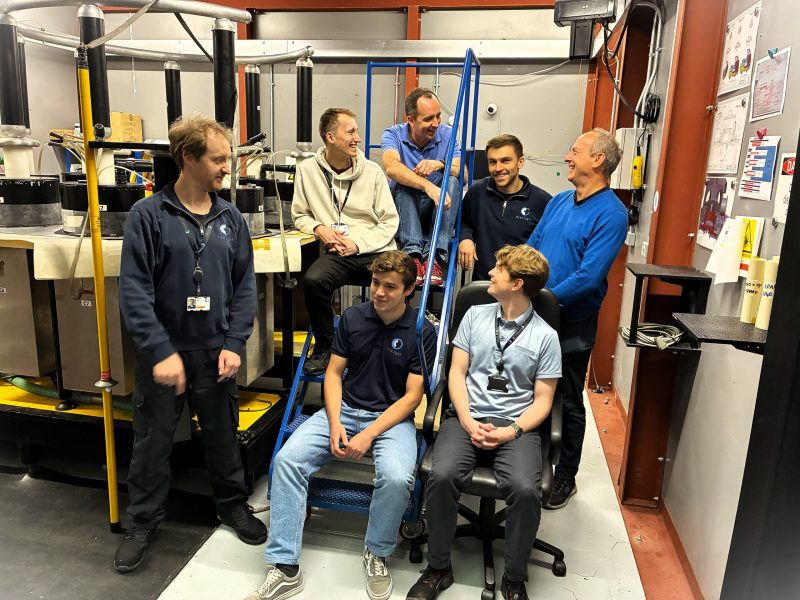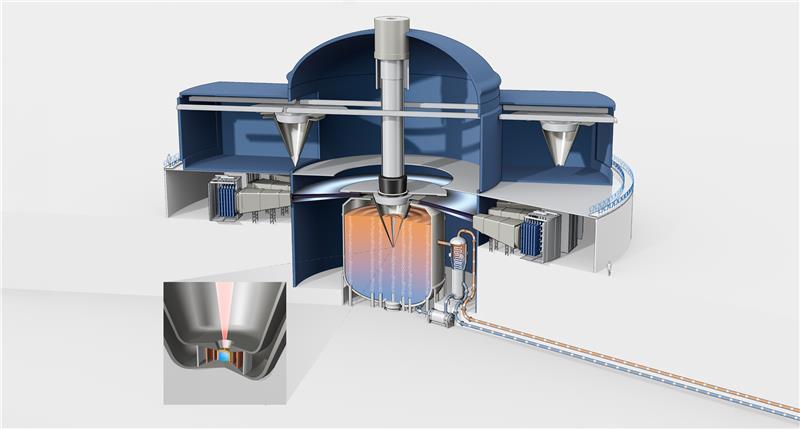- UKAEA and First Light Fusion to construct a new facility to house First Light’s new net energy gain demonstrator (“Machine 4”) in Oxford, UK
- The agreement will see both parties developing the building at Culham Campus
- Architects and technical designers have been appointed, construction expected to begin in 2024
- Machine 4’s unique approach to inertial confinement fusion is its next milestone towards commercial fusion power development
25 January 2023, Oxford, UK: The UK Atomic Energy Authority (‘UKAEA’) and First Light Fusion (‘First Light’) have today signed an agreement for the design and construction of a new purpose-built facility to house First Light’s Machine 4 at UKAEA’s Culham Campus in Oxfordshire.
This further adds to Culham Campus’s status as a leading location for public-private partnerships in fusion energy development.
The partnership with UKAEA and the announcement of the proposed construction of the building for Machine 4 follows the recent confirmation of net energy gain by the National Ignition Facility (NIF), at Lawrence Livermore National Laboratory.
Like NIF, First Light is pursuing an “inertial confinement” approach to fusion. First Light’s method leverages the same physics proven by NIF but combines it with a unique approach which involves firing a projectile at a fuel pellet to force it to fuse and produce energy. This approach has been validated by UKAEA.
Although the machine itself will not generate power, it will be used to develop technology needed for future inertial confinement fusion energy powerplants.
First Light has appointed technical building design specialists, Ramboll, and architects, Scott Brownrigg. Construction is anticipated to begin in 2024 with operations likely to commence in 2027.
First Light believes locating Machine 4 at Culham Campus will bring significant advantages that will expedite its development, including UKAEA’s existing expertise and supply chain infrastructure. First Light has worked constructively with UKAEA for many years.
Professor Sir Ian Chapman, CEO of UKAEA, said:
“We are delighted that this First Light Fusion demonstration facility will be at Culham. We have enjoyed a long relationship with First Light Fusion as it has progressed its unique projectile fusion method, and worked with them to validate their maiden fusion result in 2022. First Light joins other fusion pioneers in working at Culham as we continue to drive UK economic growth and a thriving fusion industry.”
Dr Nick Hawker, Co-founder and CEO of First Light Fusion, said:
“We welcome the continued support of the UKAEA and look forward to working with them to rapidly advance the construction of this facility and our gain machine. With this agreement in place, and contracts signed with designers and architects, we can accelerate our development timeframe. The recent gain result from the National Ignition Facility in California proved what we always knew – that inertial confinement fusion works and offers the potential for a faster route to commercial fusion. It also had considerable positive repercussions for us at First Light. Our approach leverages the same physics now proven by NIF but combines it with a unique approach that gets to a competitive cost point in a truly scalable manner. We’ve already proven fusion. Gain is our next milestone. We are very confident Machine 4 will allow us to achieve this, while we continue to develop plans for a pilot commercial fusion powerplant.”
About Machine 4
First Light’s unique “inertial confinement” approach to achieving fusion involves compressing a target containing fusion fuel using a projectile travelling at a tremendous speed.
Similar technology exists in the US. The Z-machine at Sandia National Labs (https://www.sandia.gov/z-machine/) is currently the largest ‘pulsed power’ machine in the world. It uses high magnetic fields associated with fast, intense electrical currents to produce high temperatures, high pressures, and powerful X-rays for research in high energy density physics.
Machine 4 will have a stored electrical energy of c.100 mega joules with the capability of launching projectiles at 60 kms per second. This speed on impact inside the target will accelerate to c.200kms per second as a result of First Light’s exclusive amplifier technology. The amplifier focuses the energy of the projectile into the fusion fuel, both boosting the pressure from impact to deliver to the fuel and shaping the waves to produce spherical implosions. This approach has been recently proven by NIF in California. First Light’s current ‘pulsed power’ machine, Machine 3, launches a projectile at c. 20kms per second.
First Light is aiming for net energy gain with Machine 4, exemplified by a fuel gain of 100 or more. This machine is the building block for the pilot power plant, validating First Light’s simulation codes, while de-risking the design of high-gain targets for power production.
About First Light Fusion
First Light Fusion was founded by Professor Yiannis Ventikos, Head of the Mechanical Engineering Department at University College, London, and Dr Nicholas Hawker, formerly an Engineering lecturer at Lady Margaret Hall, Oxford.
The company was spun out from the University of Oxford in July 2011, with seed capital from IP Group plc, Parkwalk Advisors Ltd and private investors. Invesco and Oxford Science Enterprises provided follow-on capital.
The business has grown from a research-focused university project to a fully-fledged company that has developed not only a strategy for how to make fusion energy work, but also a sustainable business model based on the technology.
The team comprises experts in relevant scientific and engineering fields plus the management experience necessary to address the challenges which lie ahead. The company has been able to attract a world class advisory board, meaning it can benefit from decades of relevant experience to help it streamline the path towards realising its vision.
About UKAEA
UK Atomic Energy Authority (UKAEA) is the national research organisation responsible for the development of fusion energy.
Fusion energy has great potential to deliver safe, sustainable, low-carbon energy for generations to come. It is based on the same processes that power the sun and stars, and would form part of the world’s future energy mix. Achieving this is a major technical challenge that involves working at the forefront of science, engineering, and technology.
UKAEA’s programmes include the MAST-Upgrade (Mega Amp Spherical Tokamak) fusion experiment and the JET (Joint European Torus) fusion research facility, operated for scientists from around Europe in Culham, Oxford. STEP (Spherical Tokamak for Energy Production) is UKAEA’s ambitious programme to accelerate the delivery of fusion energy, with plans to deliver a prototype powerplant producing net electricity in the 2040s in Nottinghamshire.
UKAEA also undertakes cutting edge work with academia, other research organisations and the industrial supply chain in a wide spectrum of areas, including robotics and materials.
More information: https://www.gov.uk/ukaean Social Media: @UKAEAofficial



